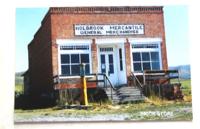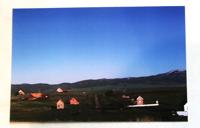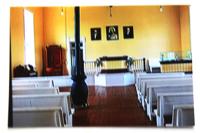CHESTERFIELD, ID – Historic Chesterfield, Idaho is one of the most well-preserved ghost towns in Idaho. Founded in 1880 by early members of the Church of Jesus Christ of Latter-Day Saints along the Oregon Trail, Chesterfield is nestled in farm ground north of Bancroft between Soda Springs and Lava Hot Springs.
Jack and Penny Jensen, currently living in Avon, spent nearly 15 years as directors of the Chesterfield Foundation, an organization formed in 1980 to take responsibility of the townsite and restore homes and businesses. They also offered tours of the 162-acre town. Some homes are made of brick and some logs. The bricks were made and fired in kilns near the town.
The Jensens spent most of their lives in the Boise area. When they retired, they spent summers in the abandoned town.

A photo of the restored tore in Chesterfield. where visitors can buy merchandise
They wanted to give visitors a sense of how life was in Chesterfield’s prime.
“It’s got quite a history, it’s a wonderful place,” Jack said. “We call it a healing place, a quiet place in a beautiful valley. We very much like spending time there.”
All of the buildings are unoccupied except for the director’s house, which has running water and other modern conveniences. The directors live in the restored home from Memorial Day until Labor Day when the town is active with volunteers and visitors.
“My mom and dad and my wife’s mother were from Chesterfield,” he said. ”About 1955 it really developed into a ghost town.”
It was founded in 1880 by Chester Call. He was a bishop for the Church of Jesus Christ of Latter-day Saints in Bountiful and purchased 300 horses from the tithing office. He was looking for a place to put them when he found the place in southern Idaho.
“He looked for a place in Utah and Wyoming and finally found some tall grass and space in Idaho where he thought the horses would flourish,” Jensen said. “He went back to Bountiful and talked about 20 families to come to Idaho to live.”
Unlike other early Latter-day Saint pioneer communities that Brigham Young sent people to settle, Chesterfield was settled by people from Utah who chose to go out on their own.
They built three stores, two log ones and one brick one. The brick store has been restored and they sell homemade jams, pioneer toys and other merchandise. All the profits go to the foundation. The brick homes were built using area materials and the spot where the kilns were are still there.
Chesterfield residents helped some 54,000 travelers make their way along the Oregon trail that runs right through the town.

One of Jack Jensen’s photos of the ghost town Chesterfield taken from a distance.
One of the buildings, a meeting hall, was used as a church building and other social gatherings. It has been restored close to the way the original building was with pews, a rostrum and an old potbelly stove. It has outer brick walls and inner brick walls. The interior is painted lath and plaster, the way it was.
By 1884 there were 136 people and 24 families living there when the Chesterfield Ward was established. The population continued to grow to 73 families containing 418 people in the Chesterfield Ward. By 1908, fewer than 400 people were left in the area and only 208 people in the Chesterfield Ward.
The population of the town peaked at just under 700 people in the Chesterfield area by 1920. There were several factors that caused the decline in population.
“There was a cold spell after a couple years of drought,” he said. “It got down to 50 below zero and froze a bunch of sheep.”
Then there was sickness that took some lives of those in the southern Idaho town. People left after WWI and WWII and the Great Depression to find a better way of life.
By 1955 the town was abandoned.
Randy Ruger, the current director of the Chesterfield Foundation, said all of the board members are volunteers, including him.
“We have a membership of 200 plus people and we have 14 board members that are elected on a three year term,” he said. “We’re completely staffed by volunteers.”

One of Jack Jensen’s photos of the interior of the meeting hall in Chesterfield.
Ruger said they are helped financially from donations, and they make a little money from the store.
“We have to rely on some wealthy benefactors for support,” he said.
They give free tours Monday through Saturday.
“We hope that people will come experience the town and donate to our cause or buy some of our stuff at the store,” Ruger said. “We get a couple of grants that help us.”
Youth groups and families come up and use the 13 handcarts they have available.
“There is also a campground people can use with running water and showers,” he said. “We also have a place for RV’s.”
Every house in Chesterfield has a story and the volunteers can paint a picture of the people that lived in one of Idaho’s best preserved ghost towns.




